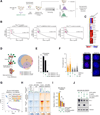SMARCAL1 is a dual regulator of innate immune signaling and PD-L1 expression that promotes tumor immune evasion
- PMID: 38301646
- PMCID: PMC10980358
- DOI: 10.1016/j.cell.2024.01.008
SMARCAL1 is a dual regulator of innate immune signaling and PD-L1 expression that promotes tumor immune evasion
Abstract
Genomic instability can trigger cancer-intrinsic innate immune responses that promote tumor rejection. However, cancer cells often evade these responses by overexpressing immune checkpoint regulators, such as PD-L1. Here, we identify the SNF2-family DNA translocase SMARCAL1 as a factor that favors tumor immune evasion by a dual mechanism involving both the suppression of innate immune signaling and the induction of PD-L1-mediated immune checkpoint responses. Mechanistically, SMARCAL1 limits endogenous DNA damage, thereby suppressing cGAS-STING-dependent signaling during cancer cell growth. Simultaneously, it cooperates with the AP-1 family member JUN to maintain chromatin accessibility at a PD-L1 transcriptional regulatory element, thereby promoting PD-L1 expression in cancer cells. SMARCAL1 loss hinders the ability of tumor cells to induce PD-L1 in response to genomic instability, enhances anti-tumor immune responses and sensitizes tumors to immune checkpoint blockade in a mouse melanoma model. Collectively, these studies uncover SMARCAL1 as a promising target for cancer immunotherapy.
Keywords: AP-1; CRISPR-Cas9 screens; DNA damage response; JUN; PD-L1 regulation; SMARCAL1; cGAS-STING pathway; cancer immunotherapy; cancer-intrinsic innate immunity.
Copyright © 2024 Elsevier Inc. All rights reserved.
Conflict of interest statement
Declaration of interests EpiCypher is a commercial developer and supplier of reagents and platforms used in this study. All authors affiliated with EpiCypher own shares in (with M.-C.K. also a board member of) EpiCypher Inc. B.I. is a consultant for or received honoraria from Volastra Therapeutics, Johnson & Johnson/Janssen, Novartis, Eisai, AstraZeneca, and Merck and has received research funding to Columbia University from Agenus, Alkermes, Arcus Biosciences, Checkmate Pharmaceuticals, Compugen, Immunocore, and Synthekine. A. Califano is founder, equity holder, and consultant of DarwinHealth Inc., a company that has licensed some of the algorithms used in this manuscript from Columbia University. Columbia University is also an equity holder in DarwinHealth Inc.
Figures







References
-
- Freeman GJ, Long AJ, Iwai Y, Bourque K, Chernova T, Nishimura H, Fitz LJ, Malenkovich N, Okazaki T, Byrne MC, et al. (2000). Engagement of the PD-1 immunoinhibitory receptor by a novel B7 family member leads to negative regulation of lymphocyte activation. J Exp Med 192, 1027–1034. 10.1084/jem.192.7.1027. - DOI - PMC - PubMed
MeSH terms
Substances
Grants and funding
- R01 CA280414/CA/NCI NIH HHS/United States
- K99 CA273538/CA/NCI NIH HHS/United States
- S10 OD032433/OD/NIH HHS/United States
- R01 CA266446/CA/NCI NIH HHS/United States
- R01 CA197774/CA/NCI NIH HHS/United States
- S10 OD012351/OD/NIH HHS/United States
- R44 GM123869/GM/NIGMS NIH HHS/United States
- S10 OD020056/OD/NIH HHS/United States
- P30 CA013696/CA/NCI NIH HHS/United States
- S10 OD021764/OD/NIH HHS/United States
- R44 DE029633/DE/NIDCR NIH HHS/United States
- R37 CA258829/CA/NCI NIH HHS/United States
- R01 CA227450/CA/NCI NIH HHS/United States
- R01 DE031873/DE/NIDCR NIH HHS/United States
- R35 CA197745/CA/NCI NIH HHS/United States
LinkOut - more resources
Full Text Sources
Medical
Molecular Biology Databases
Research Materials
Miscellaneous

